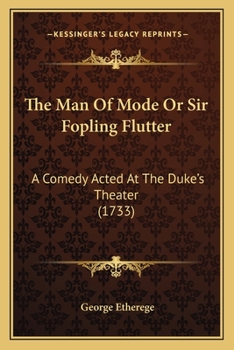The Man Of Mode Or Sir Fopling Flutter: A Comedy Acted At The Duke's Theater (1733)
Select Format
Select Condition 
Book Overview
""The Man of Mode or Sir Fopling Flutter"" is a comedy play written by George Etherege and first performed at the Duke's Theater in 1676. The play revolves around the character of Dorimant, a notorious womanizer and socialite, who is torn between his love for the virtuous Harriet and his desire for the fashionable and shallow Lady Woodvill. Along the way, he is aided by his friend, the dandy Sir Fopling Flutter, who serves as a foil to Dorimant's...
Format:Paperback
Language:English
ISBN:1165074869
ISBN13:9781165074860
Release Date:September 2010
Publisher:Kessinger Publishing
Length:98 Pages
Weight:0.31 lbs.
Dimensions:0.2" x 6.0" x 9.0"
Customer Reviews
1 rating
Classic Example of Restoration Comedy - Dialogue is Witty and Entertaining
Published by Thriftbooks.com User , 16 years ago
Rather unexpectedly, I found The Man of Mode (1676) to be entertaining comedy. Although quite popular for several decades, it began falling out of favor in the 1730s. A 1965 revival in Yorkshire was the first known production since 1793. For its humor George Etherege's play offers witty confrontations; the plot itself is not highly structured and the ending is uncertain. Through his easy wit and good nature, George Etherege, himself of more modest background, gained court favor during the Restoration period. He became a close associate of boisterous, young courtiers, wits, and rakes, especially the Earl of Rochester, Sir Charles Sedley, and the Duke of Buckingham. Playgoers apparently assumed that Etherege modeled his key characters upon these rakish aristocrats, although there was never agreement on their exact identity. The play begins as Mr. Dorimant, perhaps best described as an impulsive libertine with a good nature, is determining how to abandon his current mistress, Mrs. Loveit, without compromising his plans to gain the favors of her close friend, Bellinda. His strategy involves placing Mrs. Loveit in a situation that suggests that she has betrayed him for the attention of a recent arrival from France, a Sir Fopling Flutter. Complicating matters, a newcomer - a young, attractive, witty (and financially secure) woman named Harriet - exercises undue influence on Dorimant. Most inappropriately, Dorimant is falling in love. The Man of Mode is indeed a comedy of manners, but as is often the case with this genre there is a more serious undertone. Dorimant freely professes that the extravagant words and promises made in pursuit of love are no more meaningful than threats made in anger. By the mid-1700s public attitudes had shifted away from the looser morals of the Restoration period. Etherege's play was now roundly criticized as "a perfect contradiction to good manners, good sense, and common honesty". Even today this underlying moral issue may dilute the humor of the situation. The Man of Mode may be absent from the stage, but it is not difficult to find it in print. A good source is the Regents Restoration Drama series published by University of Nebraska Press and edited by W. B. Carnochan. The introduction is quite good. There is also a 12-page literary chronology spanning 1631-1737. New Mermaids has an edition edited by John Barnard. It offers a longer, more detailed introduction. An appendix contains the music for two songs found in the play. Another source is the Norton Critical Edition titled Restoration and Eighteenth-Century Comedy. Some two hundred pages of literary criticism were compiled by Scott McMillin. Some pertains directly to The Man of Mode.





